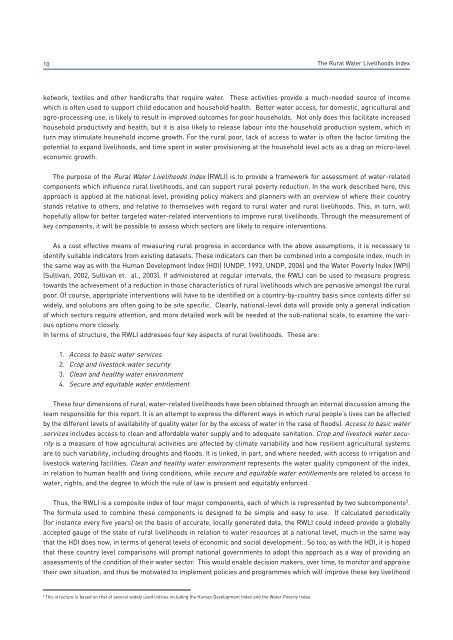The Rural Water Livelihoods Index - FAO
The Rural Water Livelihoods Index - FAO
The Rural Water Livelihoods Index - FAO
You also want an ePaper? Increase the reach of your titles
YUMPU automatically turns print PDFs into web optimized ePapers that Google loves.
10<br />
<strong>The</strong> <strong>Rural</strong> <strong>Water</strong> <strong>Livelihoods</strong> <strong>Index</strong><br />
ketwork, textiles and other handicrafts that require water. <strong>The</strong>se activities provide a much-needed source of income<br />
which is often used to support child education and household health. Better water access, for domestic, agricultural and<br />
agro-processing use, is likely to result in improved outcomes for poor households. Not only does this facilitate increased<br />
household productivity and health, but it is also likely to release labour into the household production system, which in<br />
turn may stimulate household income growth. For the rural poor, lack of access to water is often the factor limiting the<br />
potential to expand livelihoods, and time spent in water provisioning at the household level acts as a drag on micro-level<br />
economic growth.<br />
<strong>The</strong> purpose of the <strong>Rural</strong> <strong>Water</strong> <strong>Livelihoods</strong> <strong>Index</strong> (RWLI) is to provide a framework for assessment of water-related<br />
components which influence rural livelihoods, and can support rural poverty reduction. In the work described here, this<br />
approach is applied at the national level, providing policy makers and planners with an overview of where their country<br />
stands relative to others, and relative to themselves with regard to rural water and rural livelihoods. This, in turn, will<br />
hopefully allow for better targeted water-related interventions to improve rural livelihoods. Through the measurement of<br />
key components, it will be possible to assess which sectors are likely to require interventions.<br />
As a cost effective means of measuring rural progress in accordance with the above assumptions, it is necessary to<br />
identify suitable indicators from existing datasets. <strong>The</strong>se indicators can then be combined into a composite index, much in<br />
the same way as with the Human Development <strong>Index</strong> (HDI) (UNDP, 1993, UNDP, 2006) and the <strong>Water</strong> Poverty <strong>Index</strong> (WPI)<br />
(Sullivan, 2002, Sullivan et. al., 2003). If administered at regular intervals, the RWLI can be used to measure progress<br />
towards the achievement of a reduction in those characteristics of rural livelihoods which are pervasive amongst the rural<br />
poor. Of course, appropriate interventions will have to be identified on a country-by-country basis since contexts differ so<br />
widely, and solutions are often going to be site specific. Clearly, national-level data will provide only a general indication<br />
of which sectors require attention, and more detailed work will be needed at the sub-national scale, to examine the various<br />
options more closely.<br />
In terms of structure, the RWLI addresses four key aspects of rural livelihoods. <strong>The</strong>se are:<br />
1. Access to basic water services<br />
2. Crop and livestock water security<br />
3. Clean and healthy water environment<br />
4. Secure and equitable water entitlement<br />
<strong>The</strong>se four dimensions of rural, water-related livelihoods have been obtained through an internal discussion among the<br />
team responsible for this report. It is an attempt to express the different ways in which rural people’s lives can be affected<br />
by the different levels of availability of quality water (or by the excess of water in the case of floods). Access to basic water<br />
services includes access to clean and affordable water supply and to adequate sanitation. Crop and livestock water security<br />
is a measure of how agricultural activities are affected by climate variability and how resilient agricultural systems<br />
are to such variability, including droughts and floods. It is linked, in part, and where needed, with access to irrigation and<br />
livestock watering facilities. Clean and healthy water environment represents the water quality component of the index,<br />
in relation to human health and living conditions, while secure and equitable water entitlements are related to access to<br />
water, rights, and the degree to which the rule of law is present and equitably enforced.<br />
Thus, the RWLI is a composite index of four major components, each of which is represented by two subcomponents 2 .<br />
<strong>The</strong> formula used to combine these components is designed to be simple and easy to use. If calculated periodically<br />
(for instance every five years) on the basis of accurate, locally generated data, the RWLI could indeed provide a globally<br />
accepted gauge of the state of rural livelihoods in relation to water resources at a national level, much in the same way<br />
that the HDI does now, in terms of general levels of economic and social development.. So too, as with the HDI, it is hoped<br />
that these country level comparisons will prompt national governments to adopt this approach as a way of providing an<br />
assessments of the condition of their water sector. This would enable decision makers, over time, to monitor and appraise<br />
their own situation, and thus be motivated to implement policies and programmes which will improve these key livelihood<br />
2<br />
This structure is based on that of several widely used indices including the Human Development <strong>Index</strong> and the <strong>Water</strong> Poverty <strong>Index</strong>.

















